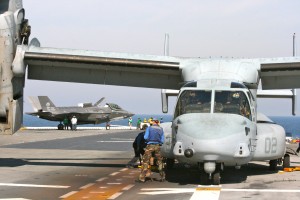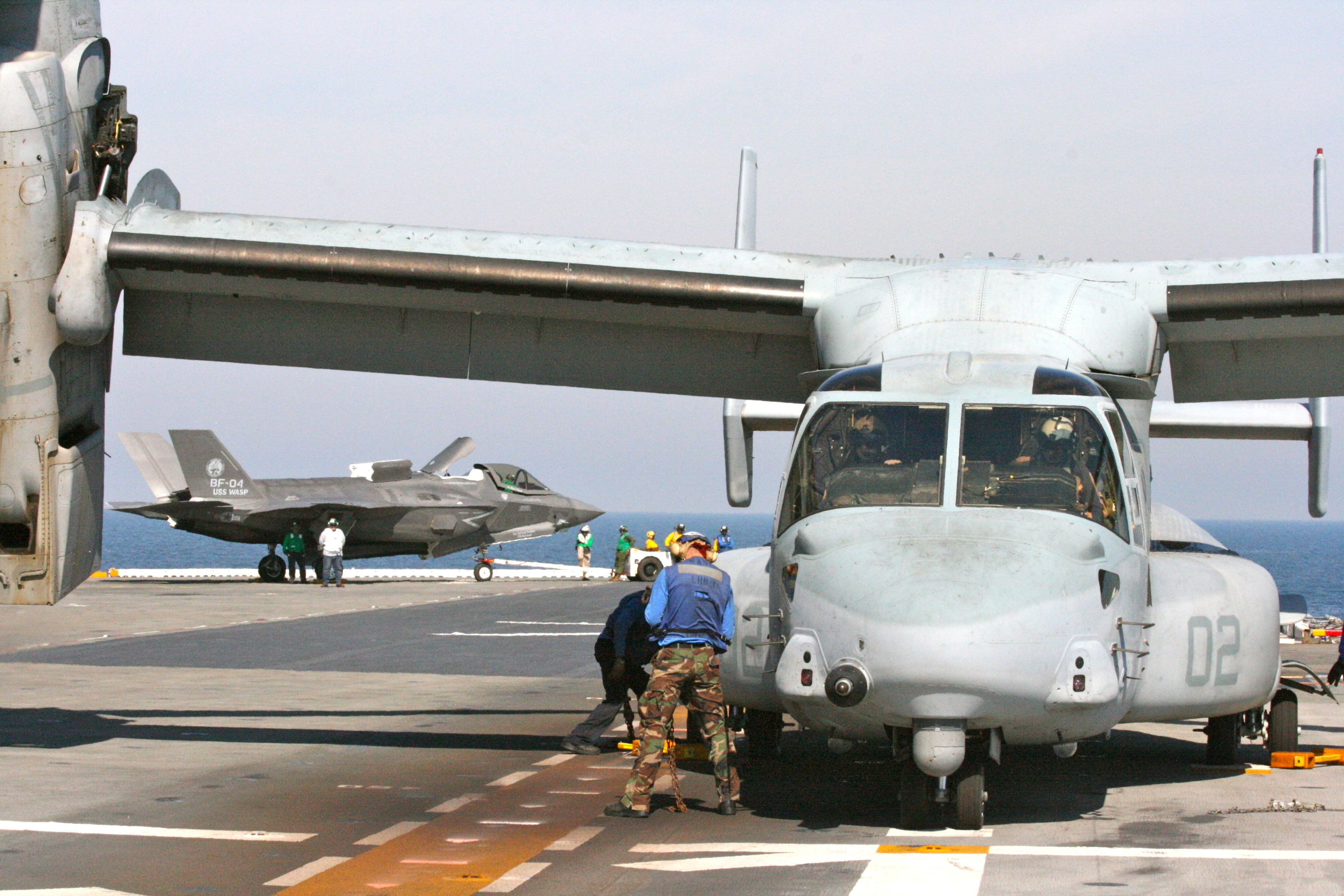10/20/2011 Second Line of Defense recently visited Marine Aviation Weapons and Tactics Squadron 1 (MAWTS) to hear first hand the effort to shape the F-35 transition. We also visited the construction team re-building Marine Corps Air Station Yuma and will report on the changes being made to operate the F-35Bs in Arizona.
The mission of MAWTS-1 is to provide standardized advanced tactical training and certification of unit instructor qualifications that support Marine Aviation training and readiness and to provide assistance in the development and employment of aviation weapons and tactics.
The days spent with MAWTS were invaluable in shaping an understanding of the impact of V-22 and F-35 on the changes in tactics and training generated by the new aircraft. MAWTS is taking a much older curriculum and adjusting it to the realities of the impact of the V-22 and the anticipated impacts of the F-35.

MAWTS is highly interactive with the various centers of excellence in shaping F-35 transition such as Nellis AFB, Eglin AFB, the Navy/Marine test community at Pax River Md, and with the United Kingdom. In fact, the advantage of having a common fleet will be to provide for significant advances in cross-service training and con-ops evolutions.
Additionally, the fact MAWTS is studying the way the USAF train’s combat pilots to be effective flying the F-16 in shaping the Marine F-35B Training and Readiness Manual (T&R Manual) is a testimony to a joint service approach. This is all extremely important in how MAWTS is addressing the future.
General “Dog” Davis, the 2nd MAW Commander, had highlighted for SLD the importance of merging three USMC pilot cultures into one.
The CG emphasized the importance of the EW culture within the USMC, and to the Prowler community within the USMC.
The Prowler guys are some of the brightest guys in the USMC.
But the F-35B was going to provide the USMC aviator cultures in our Harriers, Hornets and Prowlers to coalesce and I think to shape an innovative new launch point for the USMC aviation community.
We are going to blend three outstanding communities. Each community has a slightly different approach to problem solving. You’ve got the expeditionary basing that the Harrier guys are bringing to you. You have the electronic warfare side of the equation and the high-end fight that the Prowler guys thing about and the coms and jamming side of the equation, which the Prowler guys think about. And you have the multi-role approach of the F-18 guys.
I think it is going to be a fantastic blending of not only perspectives but also attitudes. And what I really look forward to is not the old guys like me, but the very young guys who will fly this fantastic new capability. The older generation may have a harder time unleashing the power and potential of the new gear – the new capabilities. We might say “why don’t you do it this way” when that approach might be exactly the wrong thing to do from a capabilities standpoint.
My sense is the young guys will blend. We’ve already picked the first Prowler pilot to go be an F35 guy. He’s going to do great and he’s going to add perspective and attitude to the tribe down at Eglin getting ready to fly the jet that’s going to make a big impact on the F35 community.
I think it’s going to be the new generation, the newbies that are in the training command right now that are getting ready to go fly the F35, who are going to unleash the capabilities of this jet. They will say, “Hey, this is what the system will give me. Don’t cap me; don’t box me. This is what this thing can do, this is how we can best employ the machine, its agility its sensors to support the guy on the ground, our MEU Commanders and our Combatant Commanders and this is what we should do with it to make it effective.”
https://sldinfo.com/“the-future-is-now”-clearing-the-decks-for-the-ipad-generation-pilots/
MAWTS is a key center of excellence where the curriculum will be re-shaped to provide for the C4ISR D, Z-Axis pilots.
https://sldinfo.com/the-emergence-of-the-z-axis-changing-the-way-airpower-enables-combat-operations/
The historical curriculum has been built around modules which basically reflect core platforms or tasks. The V-22 is in the module with rotorcraft. But the V-22 and F-35B do not fit in easily.
However, an emerging approach may well be to take functions and then to redesign the curriculum around those functions. For example the inherent capabilities of the emerging F-35B C4ISR-D cockpit with 360 situational awareness may turn out with appropriately designed data links to be a force multiplier in the tactical employment of the MV-22 Osprey and the Helicopter community and reach back to Navy combat forces afloat. Everything is on the table to establish a true combat effective 21st Century “no platform fights alone” reality.
We discussed this transition with several Marines at MAWTS. And we are presenting for our leaders the MAWTS understanding of the transition from the standpoint of 4 key members of the effort.
Major Derek Branon, head of the TACAIR department within MAWTS explains the nature of the transition from the F-18, AV-8B and EA-6B to the F-35B. MAWTS is the key tactics and training center in the USMC for air operations within the MAGTF and the MEU.
Major Branon underscored that they were using scenario based training as a means to re-shape the curriculum. The focus on mission essential tasks allows looking at the impact of the F-35B on new approaches. The aircraft is very flexible so one can look at air-to-air, TRAP, CAS support and EW brought together in a new approach to conops. The shift is from a target oriented pilot culture to a mission or task oriented pilot culture.
Major Joshua Smith, head of the MV-22 division within MAWTS explains the transition for the V-22 and how it operates differently for the USMC. MAWTS is the key tactics and training center in the USMC for air operations within the MAGTF and the MEU.
Major Smith underscored how the experience with the V-22 transition is being looked at to shorten the lessons learned necessary to incorporate the F-35B into USMC mission sets.
The paradigm shift is underway with the deployment of the MV-22 and extrapolating from how it is currently working with the Harriers. “You will see exponential expansions of the distances and the capabilities you can take forward on the ARG.”
Major Shoop is the F-35B lead at MAWTS in shaping the new training and tactics curriculum for the introduction of the aircraft into the Weapons and Tactics Instructor (WTI) Course. Major Shoop explains the nature of the transition associated with having a Z axis plane. EW inside the cockpit is a new capability for a combat aircraft. . MAWTS is the key tactics and training center in the USMC for air operations within the MAGTF and the MEU.
Major Kevin Crespo works with Major Shoop on developing and shaping the new training and tactics curriculum for the introduction of the F-35B into the Weapons WTI Course. Major Crespo explains the impact of the F-35B on the Amphibious Ready Group (ARG).
Major Crespo talked about the newly enabled ARG. He focused on the ability of the newly enabled ARG to operate in insertion seems rather than frontal assaults. The ability of the ARG to become a much more effective and scalable asset. He emphasized the growing challenge of operating globally to insert force without the F35-B. “Being able to keep the other side puzzling over what we are bringing ashore and where is a key strategic advantage.”
We concluded our visit by discussing the question “What impact will the first 6 F-35Bs aboard an ARG have on the first operations?”
There are obvious significant and revolutionary air-to-air implications, but much of our discussion as very appropriate for US Marines revolved around the support to the 0311 fire team leader.
Among the many initial impacts are the following:
- An ability to suppress enemy communications;
- An ability to deal with all missile threats;
- An ability to operate essentially as a traffic cop to provide guidance on the most effective routes into the littoral where the adversary’s forces are weakest;
The trip to MAWTS has led as well to looking at similar transitions elsewhere. First up will be a look at introducing the F-35A into Korea and the impact that would have for the defense of South Korea. And next up will be looking at the impact of the first F-35C squadron on the Gerald Ford CVN.


